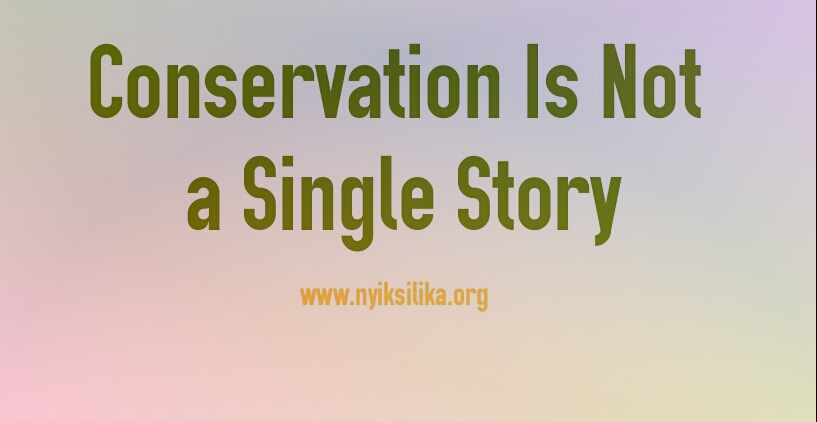The Single Story of Conservation

25 Actions you can do to be in Tune with Nature
26th June 2017
Greening the Mind one Child at a Time
12th July 2017The question of whether or not to kill one animal to save a human being, weigh very heavily on a ranger or anyone licensed to hold a gun in the field of conservation. One has to justify the reason for shooting and killing this particular wild species. In a situation where a buffalo is in the way, this is easy, and corking a gun is done without much ado. However, what if the wild species posing a threat is a rhino? A black or white rhino. In this scenario, it does not really matter which subspecies of rhino it is. It matters that this particular species is threatened. When a ranger decides to shoot and kill a rhino, despite the threat posed to humans, this will definately cause an uproar in the conservation community.
Case in point; when the lion, Mohawk, strayed to human zones, he was gunned down because “he was a danger to the people in the locality”. This was met with different views where some considered the shooting a threat and diservice to the conservation of lions in the Africa, while others thought it was a safe method to prevent the gathered crowd from being attacked by the lion.
What surprised me, in this case, was the way the situation was handled by the topmost conservation body responsible for protecting all wildlife species in Kenya; whether within the boundaries of a protected area or not. A lot of questions were raised and some are yet to be answered.
The killing of snakes can also be included in this man vs species phenomenon; who to save when a threat occurs. Many generally do not view snakes as iconic species. Killing them is normal and has been done for centuries by our parents, grand parents and even great grand parents. Would you rather suffer from a venomous bite or wrench its head out before it gets the chance to bite anyone? This is sadly the reality.
Related: Let’s Talk Snakes
Well, this is the single story of conservation. A story perceived by a majority. Where, if an animal poses a danger to the livelihoods of the people, then it should be killed because ‘human life is more important’. We tend to forget that we are a part of nature. Animals, plants, bacteria, and other living organism are one package that depend on each other one way or another.
Any African who seeks the protection of wild species may not be considered to be serious by the general public and even foreigners. Nevertheless, when a foreigner has an interest in even the tiniest wild animal, he/she receives good appraisal. African Conservation, regardless of it being practiced in Africa, has been marred and westernized to fit a certain dictation. Here, procedures only follow a certain pattern, which the ‘mzungu’ has authorised.
The foreigner has taken a permanent base in African conservation such that whenever people see them in our national parks and reserves, they are always considered as harmless and special beings. When an African, who has lived with wildlife all his life, decides to collect firewood or graze his cattle inside this protected areas, then this is considered a major threat. In some protected areas, they do not allow locals to ‘trespass’ through the park since tourists will view them as uncultured and therefore ruin the business. It is a fact that some places experience extreme overgrazing and illegal logging activity. I consider this is because the locals only believe one single story. The story that these places belong to the foreigner, so they tend to invade at their own risk.
It is also considered, to make it in the African conservation sector, you need to have foreign backing.
The single-story of conservation experienced in Africa only portrays one area and is a risk to the future of wildlife and their habitats, not forgetting humanity. It becomes a danger when we, as Africans, do not appreciate what we have as much as the foreigner does. When the only African people think about when they look at the environment is Prof. Wangari Maathai, yet she was not recognized as so when she fought for our natural resources. Nevertheless, when the western world noticed her efforts, she was awarded the Nobel Peace prize and automatically became ‘our child’. There are so many hardworking Africans striving to protect our biodiversity.
Related: The Big Conservation Lie Book review
What if I told you, despite the bite of unemployment in Kenya and Africa at large, there are still young people who would rather protect our biodiversity than sit down, wait and watch it all go downhill. What if I told you, Africans are getting educated on natural resources from the primary to tertiary levels of education and are willing to share the knowledge. This is no longer a westernized ideology. Wildlife films and documentaries are mostly done by the western world, even when they are filmed in Africa. You only see an African when they are helping with the luggage or assisting in tracking.
However, I believe a time will come when Africans will be the narrators; the ones at the forefront telling the story of our biodiversity. Will this be accepted and viewed by the western world? This is of no importance because those who should see our biodiversity are us. If we have journalists who have exquisite voices, then we can also narrate our own stories on conservation.
The wildlife photography field has long been considered a western ideology so is traveling. Over time, Africans have embraced it and have gone to extreme lengths (like foreigners) to take breathtaking wildlife photos and scenery and discover other African countries.
The single-story of conservation should be considered a dead narrative and be rebranded. Africans are now appreciating and embracing what surrounds them. Yes, we still have a long way to go, but it is a journey on its own. Not because the foreigner has told us the importance of biodiversity but because of leaders like Prof. Wangari Maathai, Jim Justus Nyamu, Judy Wakhungu, Dr. Paula Kahumbu, Pat Awori, Dr. WInnie Kiiru among others, who remind us of the importance of protecting what is rightfully ours.
The youth who are ready, optimistic, and willing to learn about Africa’s biodiversity should wait no longer to spread the message of conservation. African photographers, filmmakers and travel enthusiasts, should continue to leave a mark in the global village.
Related: 10 Kenyan Songs that Speak on Environmental Awareness
We become impressionable and vulnerable when faced with a single story. Our mindset can however change. To phase out the single story as a conservation community, we should change how we highlight the importance of biodiversity to the public. Ambushing the public with scientific terms on biodiversity will not solve the problem of the single story; of it being a Western creed. The term conservation needs a revolution.
The single story creates stereotypes, and the problem with stereotypes is not that they are untrue, but that they are incomplete. They make one story become the only story…
The consequence of the single story is this: It robs people of dignity. It makes our recognition of our equal humanity difficult. It emphasizes how we are different rather than how we are similar…
…When we reject the single story, when we realize that there is never a single story about any place, we regain a kind of paradise. – Chimamanda Ngozi Adichie






7 Comments
Hi Vicki, this blog post is such an eye opener. We tend to appreciate our heroes when they are recognised out there. This ought to stop. We need to change our mindsets as you have clearly laid it out. What a wonderful piece… And a captivating title as well…
True. We should be more appreciative of our own.
This is a wonderful piece, and yes, the single story is a tragedy in-waiting. Africa is wonderful but we[Africans] ought to realise this and embrace our own diversity in our own uniqueness. Let us tell our own stories, our genuine stories
Stories told by us (Africans) have more meaning.
[…] Related: The Single Story of Conservation […]
[…] The Single Story of Conservation […]
[…] the Single Story of Conservation? Well here we are. Highlighting Kenyans, young, both physically and at heart, showcasing our […]